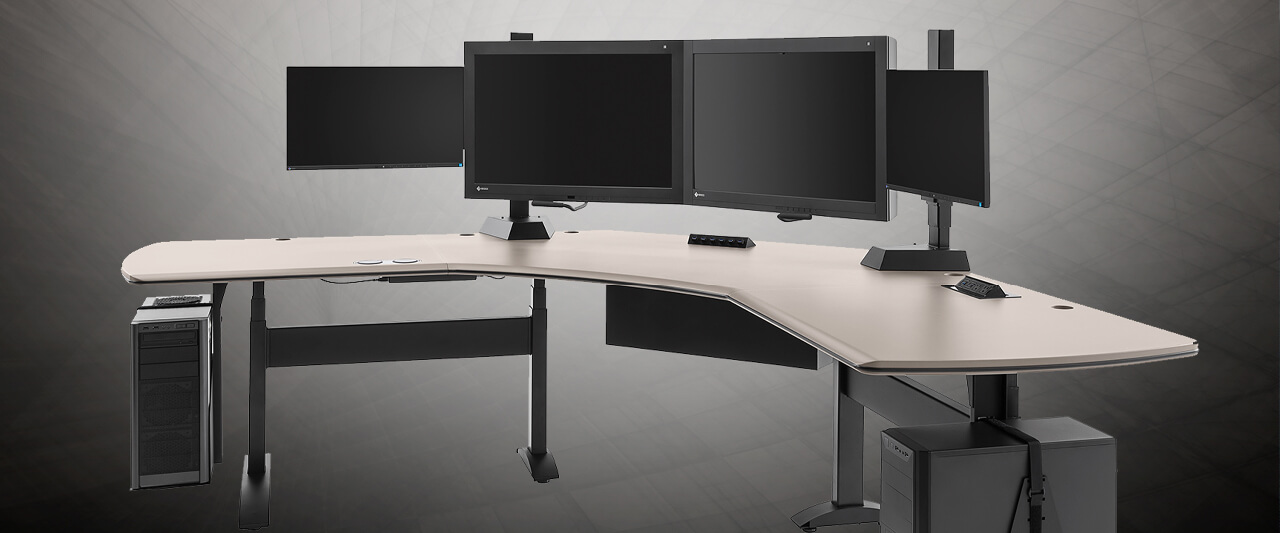
We collect basic website visitor information on this website and store it in cookies. We also utilize Google Analytics to track page view information to assist us in improving our website.

In the field of radiology, precision, efficiency, and diagnostic accuracy are essential for patient care and treatment decisions.
We have devoted the past two decades to creating a comfortable and ergonomically optimized workspace for radiologists so that these healthcare institutions can significantly improve the overall quality of diagnoses while simultaneously safeguarding the well-being of their medical professionals.
In today’s blog post, we will explore the pivotal role of ergonomic workstations in bettering radiology diagnostics. We will also share a few of our key product offerings to give you a better understanding of our capabilities.
At RedRick Technologies, we design and develop ergonomic workspaces for healthcare professionals that include workstations, monitor mounting solutions, accessories, and peripherals. We also provide ergonomic design services that help organizations implement ergonomic principles for improved space design and functionality. Get in touch and let’s find ways to improve the ergonomic functionality of your workspace.
Understanding radiology diagnostics is essential for accurate medical imaging, allowing healthcare professionals to visualize and diagnose various conditions within the human body. Accurate diagnostics play a life-saving role in disease detection, treatment planning, and monitoring patient progress.
That being said, radiologists come across many challenges in their daily work, including the sheer volume of imaging studies to interpret, the need for fast and accurate diagnoses, and the potential ergonomic issues associated with extended periods of reading and analysis.
Ergonomics, in the context of workplace design, refers to the science of creating environments and equipment that fit the capabilities and limitations of the human body, promoting both efficiency and well-being.
For radiologists, poor ergonomics in their workstations can have lasting consequences, leading to musculoskeletal issues, eye strain, and decreased productivity.
This is why we believe that ergonomic workstations are an essential part of the radiologist's environment.
Ergonomic workstations are purposefully designed setups that prioritize the physical comfort and well-being of professionals during their tasks. In the context of radiology, where precision and focus are paramount, ergonomic workstations play a pivotal role in ensuring that radiologists can perform their tasks with minimal physical strain and maximum efficiency.

Ergonomic workstations go beyond mere aesthetics; they are meticulously crafted to align with the natural movements and postures of the human body. This alignment reduces the risk of discomfort, fatigue, and repetitive strain injuries that often result from prolonged periods of sitting and intense concentration. By minimizing physical strain, ergonomic workstations enable radiologists to maintain a higher level of focus and cognitive performance throughout their tasks. This, in turn, directly contributes to accurate image interpretation and diagnosis.
Although chairs are necessary for any desk environment, we believe that the best ergonomic practice is to get out of the chair as much as possible. Our bodies are made to move and stand rather than sit. However, given the nature of most work environments, that is not always possible.
To combat this, ergonomic chairs are designed to provide proper lumbar support and adjustability to accommodate individual preferences and body types. This ensures that radiologists can maintain a neutral spine position, reducing the risk of back pain and discomfort during long reading sessions.
The ability to adjust the desktop height to accommodate all body types whether sitting or standing is one of the three critical components of an ergonomic workstation.
This ensures that shoulders, arms and wrists are in neutral positions when using keyboards, mice and other workflow-related devices.
The position of the monitor is critical to prevent strain on the neck and eyes. The top of the screen should be at or just below eye level, and the monitor should be positioned at a comfortable distance to avoid unnecessary eye strain and fatigue.
An ergonomic workstation suitable for radiology reading rooms will provide easy adjustment of the entire monitor set simultaneously for height relative to the mouse and keyboard surface and forward/back for preferred focal distance.
Adequate lighting is essential for clear image visualization and preventing eye strain. This is best achieved using a dimmable light source that is behind the monitors, positioned at the level of the desktop and illuminating up towards the ceiling casting a glow on the wall behind the workstation with some light reflecting back down from the ceiling.
This creates an illuminated visual field surrounding the monitors. By balancing the illumination from the monitors and the surrounding visual field, visual acuity can be increased and eye fatigue decreased.
The benefits of ergonomic workstations show the positive impact that they can have on radiology diagnostics, benefiting both the radiologists and the patients they serve. Here are a few to keep in mind:
Improved Comfort: Ergonomic workstations are designed to provide radiologists with ergonomic chairs and properly positioned monitors, reducing physical strain during long hours of image interpretation.
Enhanced Diagnostic Accuracy: By minimizing discomfort and distractions, ergonomic workstations help radiologists maintain their focus and concentration, which is crucial for accurate diagnosis, especially in cases where subtle details matter.
Increased Workflow Efficiency: Ergonomic setups optimize the placement of monitors, keyboards, and mice, streamlining the radiologist's workflow. This leads to quicker access to patient data and more efficient navigation through medical imaging software.
Reduced Fatigue: Ergonomically designed workstations promote better posture, reducing the risk of fatigue and discomfort during prolonged reading sessions. This results in radiologists remaining alert and less prone to errors.
Lower Risk of Musculoskeletal Issues: Proper ergonomic design minimizes the risk of musculoskeletal problems, such as back pain and carpal tunnel syndrome, which can be debilitating and lead to medical leave, ultimately impacting patient care.
Enhanced Collaboration: Ergonomic workstations often allow for multiple monitors and adjustable configurations, facilitating collaboration among radiologists and other healthcare professionals by enabling the sharing of images and insights.
Increased Job Satisfaction: Improved comfort and reduced physical strain contribute to higher job satisfaction among radiologists, potentially improving staff retention rates and overall workplace morale.
Cost Savings: While ergonomic workstations may represent an initial investment, the long-term cost savings from reduced healthcare expenses and increased productivity can be substantial, making them a financially prudent choice for healthcare institutions.
There is no need to flip through a catalogue. Every RedRick proposed solution is specifically created and customized to meet your needs. Our thoughtfully designed products are adjustable, intuitive, and extremely robust, ensuring prolonged comfort and productivity.
Our approach centers around flexibility and customized solutions. We recognize that every situation is unique, and our goal is to create spaces that perfectly fit the needs. Our guiding principle is prioritizing ease of use – a crucial aspect in all our designs. We specialize in seamlessly integrating ergonomic adjustments into even the most complex environments, like radiology reading rooms.
Our expertise lies in making these spaces user-friendly and effortlessly adaptable, ensuring that professionals can work comfortably and efficiently, no matter how challenging the setting may be.
Our recommended/standard range of adjustment is 24-49.5” above the floor
ANSI BIFMA standard of 22-48” is also available
The size and shape of the desktop are limitless and determined by physical space available, computer hardware to be hosted, and user preference.
Motorized height adjustment providing 12” of vertical range
All monitors adjust simultaneously
Virtually any monitor configuration can be accommodated
Effortless manual adjustment, found to be the most intuitive and easy-to-engage method, providing 16” of horizontal forward/back range as well as 60 degrees of side-to-side swivel
Virtually any monitor configuration can be accommodated
Our monitor mounts can handle the heaviest monitor setups. These monitor mounts are designed to accommodate large, high-resolution displays and multiple screens for demanding tasks.
Unlike traditional “split-level” or “keyboard tray” models, RedRick’s mounts allow for single-work-surface solutions that retain maximum useable space, while providing superior, intuitive, and easy ergonomic adjustment.
Our products are thoughtfully designed and customized with your needs and daily rhythms in mind, and they optimally support the critical patient care service that radiologists provide.
The work of radiologists is essential. They deserve the workstation and ergonomic environment to perform their job optimally.
Workstations cannot be an afterthought. They are essential in the diagnostic and healthcare industry and should be designed as such. In the same way, a surgeon requires an optimized operating room, so does a radiologist require an ergonomic and thoughtfully designed work environment.
Get in touch and let’s find ways to improve the ergonomic functionality of your workspace.